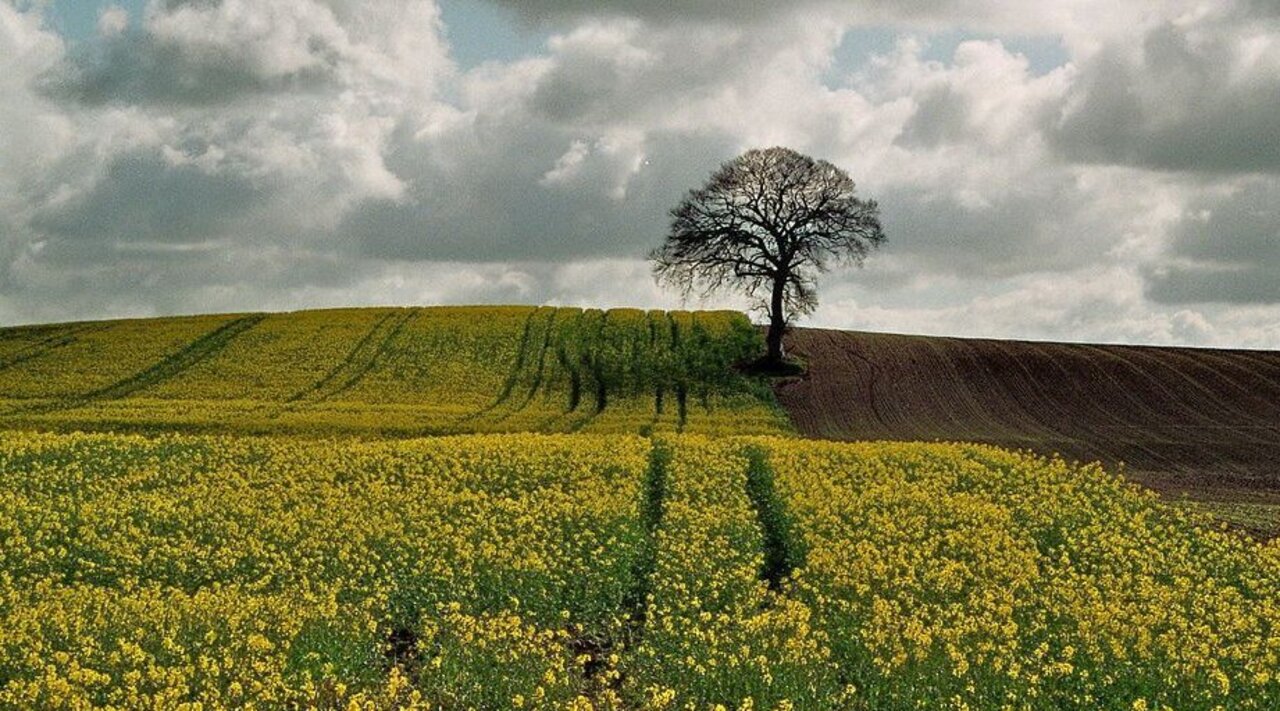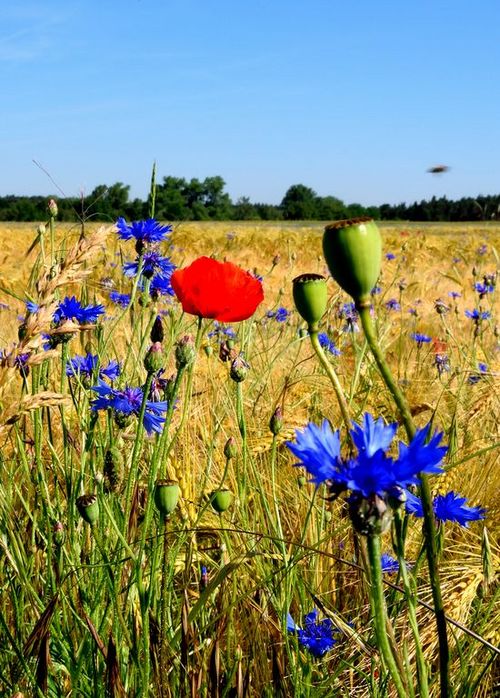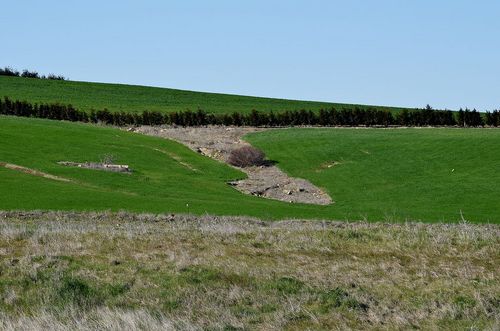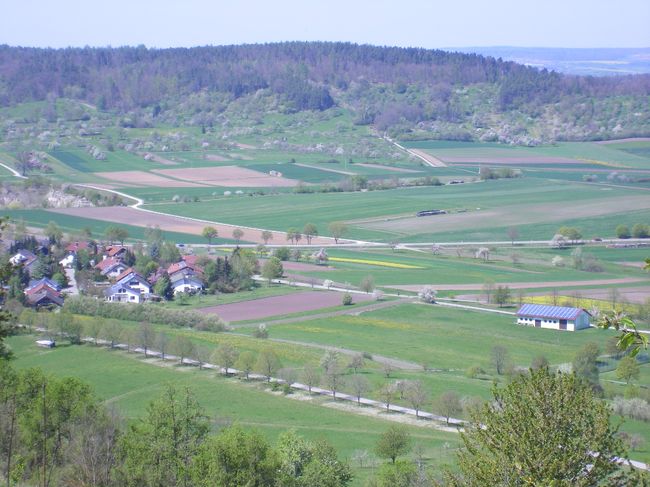Project
Superior project Greening: Accompanying ecological research on the ecological effectiveness of the Common Agricultural Policy

Accompanying ecological research on the greening of the Common Agricultural Policy
With the last two reforms of the Common Agricultural Policy, the EU Commission is pursuing the goal of aligning support policy more closely with environmental concerns. How effective the individual measures, e.g. greening in the 2014-2022 funding period and the eco-schemes in the 2023-2027 funding period, are for nature conservation and environmental protection is controversially discussed. In various projects, we are therefore investigating questions about the ambition level in terms of the use of funds and the distribution of measures on agricultural land, as well as their effectiveness.
Background and Objective
Significant species decline in agricultural landscapes, continuing high nutrient inputs in soils and waters as well as European and global stipulations for biodiversity protection require an agriculture that focuses more on ecological aspects. To address these needs the European Commission introduced a “greening” through the reform of the Common Agricultural Policy (CAP) that should strengthen the ecological sustainability of agriculture.
Since 1 January 2015, a part of the direct payments of the first pillar is linked to farming practices promoting climate and environmental protection with three measures:
- Crop diversification: Most farms with more than 30ha arable land have to cultivate at least three crops. The major crop must not exceed 75% of the area and the share of the other two crops must cover at least 5% of area each. Farms with 10 to 30ha arable land must cultivate at least two crops, whereas the major crop must not cover more than 75% of the area.
- Preservation of permanent grassland: Permanent grassland reported as a flora-fauna habitat (FFH) area is labeled as environmentally sensitive grassland and is subject to a prohibition of conversion and ploughing. Permanent grassland that is not declared as environmentally sensitive can be converted exclusively with authorization. Normally, an authorization is only given when permanent grassland is newly established to the same extent at another place in the same region and when the share of permanent grassland of the region declined by no more than 5% between 2012 and 2015.
- Declaration of ecological focus areas on arable land: Farms with more than 15ha arable land must declare 5% of their cropland as an ecological focus area. Different EFA types can be chosen, some of them allowing agricultural usage (e.g., short rotation coppice, catch crops) and some do not (e.g., fallow land, landscape elements).
Under certain conditions farms are excluded from greening, for example organic farms. Currently, there is a controversial discussion on the ecological effectiveness of EFA. It is also disputed whether the high administration and monitoring effort of those measures is proportionate.
For the funding period from 2022 onwards, the member states have been granted additional competence. The envisaged funding instruments, such as the eco-schemes of the 1st pillar, can be designed individually by each member state in the so-called strategic plan. This is intended to strengthen the ecological sustainability of agriculture through targeted measures. There are different options for shaping the funding structure. Either the measures are to be implemented over an area on a broadscale level. This means that for many farms the rewards of participation must outweigh the costs of participation. Or the measures should have the highest possible additional environmental effect per unit of land. This leads to a preference for demanding environmental measures that can only be implemented on a few areas and often have high specific implementation costs.
For a targeted funding strategy, it must be decided whether low environmental impact measures should be implemented across the entire agricultural area, thus giving many farms the opportunity to implement agri-environmental measures, or whether the budget should be used to address specific locations (hot spots) with very ambitious measures. In order to achieve an environmental effect, an ambition level must be set on the basis of these considerations.
Target Group
Ministries of agriculture and environment, farmers, consultants, official nature conservation, agricultural administration, European Commission
Approach
At the Thünen Institute of Rural Studies, there are several projects dealing with the effects of the greening on nature protection (see Links and Downloads). Their results are used to generate practical recommendations for the evaluation and design of the CAP.
Data and Methods
In the projects we especially analyze operational data from the federal states to find out more about the selection, implementation and ecological effects of the greening measures. The different focuses of the projects cover all three fields of the greening measures, supporting a greater contribution to ecology through agriculture in the future.
In addition, within a PhD-procject expert workshops and expert surveys on the desired ecological ambition level of the CAP at EU level were carried out.
Our Research Questions
How are the new greening regulation implemented by farmers and what influences their decisions?
What is the additional conservation value of the greening measures implemented under the current conditions?
How could the benefit of the greening be enhanced?
How could economically favourable options for farmers look that create benefits for nature protection at the same time?
What preferences do experts have for setting the level of remuneration for agri-environmental measures, including eco-schemes? What role does the effectiveness of the measures play?
Which policy support instrument in the view of experts is suitable for tackling the agri-environmental problems in the EU Member States? How should the spatial distribution of measures be managed?
Preliminary Results
The project show how, in addition to political guidelines, operation- and region-specific factors influence the choice and implementation of EFA and their ecological effectiveness.
Links and Downloads
Further projects are related to this roof project:
- Nature conservation in ecological focus areas (OEVForsch; BfN, 06/2015-12/2016)
- Evaluation of the CAP from an environmental protection point of view (GAPEval; UBA, 09/2015-08/2017)
- Effects of the new GAP framework on the grassland related biodiversity (GAPGRÜN; BfN, 11/2015-03/2018)
- Evaluation of the CAP reform from the point of view of environmental protection by means of a adatabase analysis of IACS data of the federal staets (GAPEval2; UBA, 12/2017-12/2019)
- Nature conservation development in Ecological Focus Areas - Effects on biodiversity and agricultural practice (OEVFORSCH2; BfN; 08/2017 - 06/ 2020)
- An Evaluation of the Common Agricultural Policy from the Perspective of Environmental Protection III (GAPEVAL III, 07/2020 - 06/2023)
Thünen-Contact

Involved Thünen-Partners
Duration
4.2015 - 12.2025
More Information
Funding program: BMUB - Umweltforschungsplan
Project status:
ongoing
Publications to the project
- 0
Lakner S, Röder N (2024) Die Gemeinsame Agrarpolitik der EU: Flaggschiff-Politik oder ewige Reformruine? Wirtschaftsdienst 104(3):159-164, DOI:10.2478/wd-2024-0047
- 1
Lakner S, Röder N (2024) Stilllegungs-Aus: Über den Tag hinaus denken. Top Agrar 53(5):54-55
- 2
Röder N, Krämer C, Grajewski R, Lakner S, Matthews A (2024) What is the environmental potential of the post-2022 common agricultural policy? Land Use Pol 144:107219, DOI:10.1016/j.landusepol.2024.107219
- 3
Haensel M, Scheinpflug L, Riebl R, Lohse EJ, Röder N, Koellner T (2023) Policy instruments and their success in preserving temperate grassland: Evidence from 16 years of implementation. Land Use Pol 132:106766, DOI:10.1016/j.landusepol.2023.106766
- 4
Pe'er G, Finn J, Diaz M, Birkenstock M, Lakner S, Röder N, Kazakova Y, Sumrada T, Bezak P, Concepción ED, Dänhardt J, Morales MB, Rac I, Spulerova J, Schindler S, Stavrinides M, Targetti S, Viaggi D, Vogiatzakis IN, Guyomard H (2022) How can the European Common Agricultural Policy help halt biodiversity loss? Recommendations by over 300 experts. Conserv Lett 15(6):e12901, DOI:10.1111/conl.12901
- 5
Röder N, Matthews A (2021) Eco-schemes a work in progress [online]. , zu finden in <http://capreform.eu/eco-schemes-a-work-in-progress/> [zitiert am 05.03.2021]
- 6
Röder N (2021) Payments for the environment - new turmoil around an old issue [online]. , zu finden in <http://capreform.eu/payments-for-the-environment-new-turmoil-around-an-old-issue/> [zitiert am 05.03.2021]
- 7
Pe'er G, Bonn A, Bruelheide H, Dieker P, Eisenhauer N, Feindt PH, Hagedorn G, Hansjürgens B, Herzon I, Lomba A, Marquard E, Moreira F, Nitsch H, Oppermann R, Perino A, Röder N, Schleyer C, Schindler S, Wolf C, Zinngrebe Y, Lakner S (2020) Action needed for the EU Common Agricultural Policy to address sustainability challenges. People Nature 2(2):305-316, DOI:10.1002/pan3.10080
- 8
Schoof N, Luick R, Ackermann A, Baum S, Böhner HGS, Röder N, Rudolph S, Schmidt TG, Hötker H, Jeromin H (2019) Auswirkungen der neuen Rahmenbedingungen der Gemeinsamen Agrarpolitik auf die Grünland-bezogene Biodiversität [online]. Bonn: BfN, 234 p, BfN Skripten 540, zu finden in <https://www.researchgate.net/publication/335580755_Auswirkungen_der_neuen_Rahmenbedingungen_der_Gemeinsamen_Agrarpolitik_auf_die_Grunland-bezogene_Biodiversitat_-_BfN-Skript_540> [zitiert am 04.09.2019], DOI:10.19217/skr540
- 9
Latacz-Lohmann U, Röder N (2019) Eco-Schemes: Was kommt auf die Bauern zu? Top Agrar 48(7):34-37
- 10
Röder N, Ackermann A, Baum S, Birkenstock M, Dehler M, Ledermüller S, Rudolph S, Schmidt TG, Nitsch H, Pabst H, Schmidt M (2019) Evaluierung der GAP-Reform aus Sicht des Umweltschutzes - GAPEval : Abschlussbericht [online]. Dessau: Umweltbundesamt, 291 p, Texte UBA 58, zu finden in <https://www.umweltbundesamt.de/publikationen/evaluierung-der-gap-reform-aus-sicht-des> [zitiert am 19.06.2019]
- 11
Röder N, Ackermann A, Baum S, Böhner HGS, Rudolph S, Schmidt TG (2019) Small is beautiful? Is there a relation between farmed area and the ecological output? - Results from evaluation studies in Germany : paper prepared for presentation at the 172nd EAAE Seminar "Agricultural Policy for the Environment or Environmental Policy for Agriculture?" ; May 28-29, 2019, Brussels. 15 p
- 12
Baum S, Rudolph S, Röder N, Ackermann A (2019) The unknown 25% - What kind of grassland is not reported to IACS? Grassl Sci Europe 24:116-118
- 13
Langgemach T, Ryslavy T, Jurke M, Jaschke W, Flade M, Hoffmann J, Stein-Bachinger K, Dziewiaty K, Röder N, Gottwald F, Zimmermann F, Vögel R, Watzke H, Schneeweiss N (2019) Vogelarten der Agrarlandschaft in Brandenburg - Bestände, Bestandstrends, Ursachen aktueller und langfristiger Entwicklungen und Möglichkeiten für Verbesserungen [online]. Naturschutz Landschaftspflege Brandenburg 28(2-3):4-68, zu finden in <https://mluk.brandenburg.de/lua/Agrarvoegel_NundL_2019.pdf> [zitiert am 09.06.2020]
- 14
Röder N, Grajewski R (2019) Wird die GAP durch das neue Umsetzungsmodell zielorientierter in Hinblick auf den Natur-, Umwelt- und Klimaschutz? Loccumer Prot 2019,05:73-86
- 15
Latacz-Lohmann U, Balmann A, Birner R, Christen O, Gauly M, Grajewski R, Grethe H, Martinez J, Nieberg H, Pischetsrieder M, Renner B, Röder N, Schmid JC, Spiller A, Taube F, Voget-Kleschin L, Weingarten P (2019) Zur effektiven Gestaltung der Agrarumwelt- und Klimaschutzpolitik im Rahmen der Gemeinsamen Agrarpolitik der EU [online]. Bonn: Bundesministerium für Ernährung und Landwirtschaft (BMEL), 100 p, Ber Landwirtsch SH 227, zu finden in <https://buel.bmel.de/index.php/buel/article/view/250/pdf> [zitiert am 25.07.2019], DOI:10.12767/buel.v0i0.250.g436
- 16
Grethe H, Nieberg H, Renner B, Balmann A, Birner R, Christen O, Gauly M, Latacz-Lohmann U, Martinez J, Pischetsrieder M, Spiller A, Taube F, Voget-Kleschin L, Weingarten P, Grajewski R, Röder N, Schmid JC (2019) Zur effektiven Gestaltung der Agrarumwelt- und Klimaschutzpolitik im Rahmen der Gemeinsamen Agrarpolitik der EU nach 2020 : Stellungnahme des Wissenschaftlichen Beirats für Agrarpolitik, Ernährung und gesundheitlichen Verbraucherschutz beim Bundesministerium für Ernährung und Landwirtschaft ; Mai 2019. Berlin: Wissenschaftlicher Beirat für Agrarpolitik, Ernährung und gesundheitlichen Verbraucherschutz beim BMEL, 100 p
- 17
Röder N, Ackermann A, Rudolph S (2018) Does conservation status influence the temporal development of agriculturally used permanent grassland in Germany? In: Horan B (ed) Sustainable meat and milk production from grasslands : proceedings of the 27th General Meeting of the European Grassland Federation, Cork, Ireland, 17-21 June 2018. Wageningen: Wageningen Academic Publ, pp 667-669
- 18
Birkenstock M, Röder N (2018) Gestaltung und Umsetzung der Gemeinsamen EU-Agrarpolitik ab 2021 - Übersicht über die politischen Debatten. Dessau: Umweltbundesamt, 66 p, Texte UBA 108
- 19
Nitsch H, Röder N, Oppermann R, Milz E, Baum S, Lepp T, Kronenbitter J, Ackermann A, Schramek J (2018) Ökologische Vorrangflächen: Gut gedacht - schlecht gemacht? Natur Landsch 93(6):258-265, DOI:10.17433/6.2018.50153583.258-265
- 20
Röder N, Ackermann A, Baum S, Rudolph S (2018) Status quo und aktuelle Entwicklungen der landwirtschaftlichen Flächennutzung in Deutschland [inkl. Zusatzmaterial]. Natur Landsch 93(6):250-257, DOI:10.17433/6.2018.50153581.250-257
- 21
Röder N (2018) Zur Situation der Grünlandbewirtschaftung in Deutschland : Kurzstellungnahme für den Thüringer Landtag. Braunschweig: Thünen-Institut für Ländliche Räume, 17 p
- 22
Laggner B, Röder N (2017) Does land fragmentation currently limit grazing in dairy farms in Lower Saxony, Germany? In: Porqueddu C, Franca A, Lombardi G, Molle G, Peratoner G, Hopkins A (eds) Grassland resources for extensive farming systems in marginal lands: major drivers and future scenarios : Proceedings of the 19th Symposium of the European Grassland Federation ; 7-10 May 2017. Sassari: EGF, pp 179-181
- 23
Gocht A, Ciaian P, Bielza M, Terres J-M, Röder N, Himics M, Salputra G (2017) EU-wide economic and environmental impacts of CAP greening with high spatial and farm-type detail. J Agric Econ 68(3):651-681, DOI:10.1111/1477-9552.12217
- 24
Hart K, Mottershead D, Tucker G, Underwood E, Maréchal A, Menet L, Martin I, Dayde C, Bresson C, Deniel E, Sanders J, Röder N, Osterburg B, Klages S (2017) Evaluation study of the payment for agricultural practices beneficial for the climate and the environment : final report. Luxembourg: European Commission, 248 p, DOI:10.2762/71725
- 25
Nitsch H, Röder N, Oppermann R, Milz E, Baum S, Lepp T, Kronenbitter J, Ackermann A, Schramek J (2017) Naturschutzfachliche Ausgestaltung von Ökologischen Vorrangflächen. Bonn: BfN, 192 p, BfN Skripten 472, DOI:10.19217/skr472
- 26
Lakner S, Röder N, Baum S, Ackermann A (2017) The German implementation of Greening - effectiveness, participation & policy integration with the agri-environmental programs : contributed poster to the XV EAAE Congress ; Towards Sustainable Agri-Food Systems: Balancing between Markets and Society ; Munich, Sept., 13th-15th, 2017. München, 12 p
- 27
Lakner S, Röder N, Baum S, Ackermann A (2017) What we can learn from the German implementation of greening - effectiveness, participation and policy integration with the agri-environmental programs ; Vortrag anlässlich der 57. Jahrestagung der GEWISOLA (Gesellschaft für Wirtschafts- uns Sozialwissenschaften des Landbaues e.V.) und der 27. Jahrestagung der ÖGA (Österreichische Gesellschaft für Agrarökonomie) "Agrar- und Ernährungswirtschaft zwischen Ressourceneffizienz und gesellschaftlichen Erwartungen", Weihenstephan, 13. bis 15. September 2017 Weihenstephan, 13. bis 15. September 2017 . GEWISOLA, 13 p
- 28
Gocht A, Ciaian P, Bielza M, Terres J-M, Röder N, Himics M, Salputra G (2016) Economic and environmental impacts of CAP greening : CAPRI simulation results. Luxembourg: European Commission, 56 p, DOI:10.2788/452051
- 29
Röder N, Laggner B, Osterburg B, Schmidt TG (2016) Grassland: quantification of the environmental services provision. Grassl Sci Europe 21:684-686
- 30
Nitsch H, Röder N, Oppermann R, Baum S, Schmarek J (2016) Naturschutzfachliche Ausgestaltung von Ökologischen Vorrangflächen : Praxishandbuch. Frankfurt am Main: IflS, 17 p
- 31
Luick R, Röder N (2016) The first pillar of the new CAP - implications for low input grasslands. Grassl Sci Europe 21:603-605
- 32
Schmidt TG, Röder N, Dauber J, Klimek S, Laggner A, Witte T de, Offermann F, Osterburg B (2014) Biodiversitätsrelevante Regelungen zur nationalen Umsetzung des Greenings der Gemeinsamen Agrarpolitik der EU nach 2013. Braunschweig: Johann Heinrich von Thünen-Institut, 70 p, Thünen Working Paper 20, DOI:10.3220/WP_20_2014
https://literatur.thuenen.de/digbib_extern/bitv/dn053406.pdf
- 33
Röder N, Osterburg B, Schmidt TG, Witte T de, Golla B (2014) Greening der GAP - Inhalt, Relevanz und Wechselwirkungen. Loccumer Prot 2014,05:89-109
- 34
Osterburg B, Röder N, Schmidt TG (2014) Grünlandschutz in der GAP : Erfordernisse, Erfahrungen, Erwartungen. Loccumer Prot 2014,05:121-127
- 35
Osterburg B, Röder N, Schmidt TG (2014) Weiterentwicklung der EU-Agrarpolitik nach 2014 und ihre Bedeutung für die Erhaltung der Biodiversität EUAgrarlandschaften. Natur Landsch 89(9-10):425-428

![[Translate to English:] [Translate to English:]](/media/_processed_/2/0/csm_LV_Bei_Hornburg_Quelle_Johanna_Fick_neu_da89674833.jpg)
![[Translate to English:] [Translate to English:]](/media/_processed_/2/0/csm_LV_Bei_Hornburg_Quelle_Johanna_Fick_neu_3aae309567.jpg)








